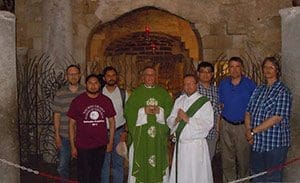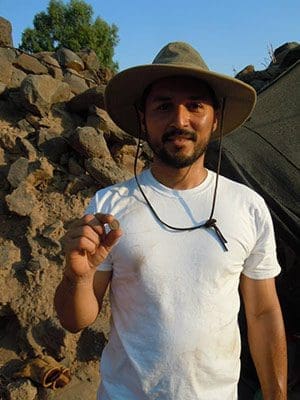In 2012, Patrick Russell, associate professor at Sacred Heart School of Theology, went to Bethsaida, Israel, to dig his hands into history.
The trip was part of the Bethsaida Excavations Project and Russell was going to participate in an  Sacred Heart School of Theology rector, Msgr. Ross Shecterle, center, and Patrick Russell, associate professor, second from right, are among the group that participated in the archeological dig last summer.archeological dig. On his first day, he found a Roman nail, approximately 2,000 years old.
Sacred Heart School of Theology rector, Msgr. Ross Shecterle, center, and Patrick Russell, associate professor, second from right, are among the group that participated in the archeological dig last summer.archeological dig. On his first day, he found a Roman nail, approximately 2,000 years old.
“You’re holding that in your hand and it doesn’t take very long to figure out the fact that Jesus, as a carpenter, held nails like this,” Russell said. “It was a direct connection to his life for me.”
From the very first day, Russell said he had a “powerful” experience while at the dig.
“I think only an archeological dig can do that,” Russell said. “You’re putting your hands in the very soil that the stories of Scripture have grown from.”
Related story |
Russell, who teaches Scripture at Sacred Heart, went back to Bethsaida last summer with six seminarians. Sacred Heart is the only Roman Catholic seminary in the United States sponsoring an archeological dig.
“We think this is going to make better priests,” Russell said last year before leaving. “They’ll have a better sense of Scripture from the standpoint of knowing where, geographically, things are at and having walked where Jesus walked, as well as the other faith heroes in Scripture.”
Russell, who has a doctorate in Scripture from Marquette University, said this kind of work is important to
|
Sacred Heart School of Theology is planning another archaeological dig in the Holy Land, open to people outside of Sacred Heart, in summer 2015. For more information, call Sacred Heart School of Theology at Read reflections written by 11 men, including Sacred Heart School of Theology rector Msgr. Ross Shecterle as they prepare for their expedition to Bethsaida, Israel this summer. Follow their experiences and view photos from the trip on their Facebook page: Bethsaida Expedition from Sacred Heart School of Theology. |
Catholics.
“You never know, (in) that bucket full of dirt, you might discover something fascinating and important to advancing our understanding of Scripture,” he said.
One of the seminarians on that archeological dig was Deacon Jose Mario Nieto Restrepo, who called it something from fantasy.
“I couldn’t believe it,” he said. “When I was there, I could only see this in the movies, you know? People doing archeology like Indiana Jones. I never imagined myself doing that.”
For him, this was a place where science and faith combined.
“I love science,” he said. “Science reaches limits that you cannot go through. That is when faith comes and helps you to make that leap.”
During the archeological dig, Deacon Nieto was part of an excavation crew that found a 10th century B.C. floor of a house.
Being one of the younger participants, Deacon Nieto was tasked with a lot of digging and heavy lifting, but he said it was worth it.
“We did it. We found it. It was really hard work,” he said, adding the experience of being in Jerusalem was surreal. “To have that dirt in my nails was a moment of deep reflection.”
It took him back to the time of Christ.
“It would remind me of the life of Jesus,” he said. “How he lived, what happened to him. Something related to that would be really awesome to find.”
During his time in Bethsaida in 2012, Russell said he discovered more nails and an ancient warehouse floor.
“As we got farther down I did uncover a floor from the eighth century,” Russell said. “People were at one point sitting on this same floor that I uncovered. People lived their lives in this one place.”
 Deacon Jose Mario Nieto Restrepo, pictured wearing his “Indiana Jones” style hat, called the experience of participating in an archeological dig in Jerusalem “surreal.” (Submitted photos courtesy Sacred Heart School of Theology)Russell said through archeology, structures can appear in front of your eyes. A boulder is just a boulder until more digging is done, then the boulder becomes a wall and then the wall becomes a room.
Deacon Jose Mario Nieto Restrepo, pictured wearing his “Indiana Jones” style hat, called the experience of participating in an archeological dig in Jerusalem “surreal.” (Submitted photos courtesy Sacred Heart School of Theology)Russell said through archeology, structures can appear in front of your eyes. A boulder is just a boulder until more digging is done, then the boulder becomes a wall and then the wall becomes a room.
“It’s sort of like a jigsaw puzzle,” Russell said. “You have a few pieces and you’re trying to figure out what pieces might fit.”
The students spent half of the time digging and the other half attending lectures and traveling to different cities. Each student paid $3,656, excluding airfare, to participate.
The seminary will take another group to the site, June 17-July 7.
“In addition to our seminarians getting credit, students from undergraduate institutions and other graduate institutions can join us as well,” Russell said. “We can grant them credit.”
